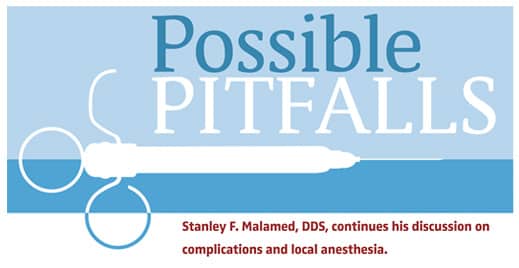
Possible Pitfalls
Stanley F. Malamed, DDS, continues his discussion on complications and local anesthesia.
 Q. Why does burning occur on injection of the local anesthetic?
Q. Why does burning occur on injection of the local anesthetic?
A. This is not a serious complication but rather an annoyance to the patient. Burning on injection is caused by the acidity of the pH in local anesthetics. When using a local anesthetic such as mepivacaine plain (3%) or prilocaine plain (4%), the pH is around 6 to 6.5, only slightly acidic. A pH of 7.0 is neutral. With the addition of epinephrine, the pH falls to about 3.5, which is considerably more acidic. As a result, when injecting a drug containing epinephrine, the patient feels a burning sensation. However, this feeling only lasts a few seconds since the drug then numbs the tissue.
One of the strategies that dental professionals can use to prevent the burning sensation is to first inject a small volume, eg, a quarter cartridge, of a plain local anesthetic. This is done primarily with the inferior alveolar nerve block. After the area is numb, a cartridge of local anesthetic containing epinephrine is used to achieve more effective pain control. The patient then can’t feel the difference in the pH.
Q. When does sloughing of tissues occur?
A. Sloughing of tissue following local anesthetic injection is rare. It occurs almost always on the palate because it is the only site in the mouth where the blood supply to the tissue can be compromised. Sloughing of the tissue most often occurs during a major procedure like extensive bridgework, implant surgery, or periodontal surgery. During these types of procedures, the dental professional wants to keep the tissue ischemic so as to minimize bleeding. An anesthetic with epinephrine is injected into the surgical site, making the tissue turn ischemic. When tissue turns white, the blood supply to that area has been shut down. The ischemia will last for approximately 10 to 20 minutes, when the tissue begins to bleed again. More local anesthesia with epinephrine is administered to maintain the ischemic state of the tissue. This causes the blood supply to the tissue to become severely compromised for an extended period of time, causing necrosis or tissue death.
From Dimensions of Dental Hygiene. January 2007;5(1): 26.

